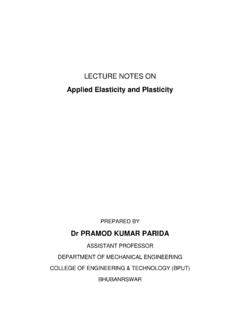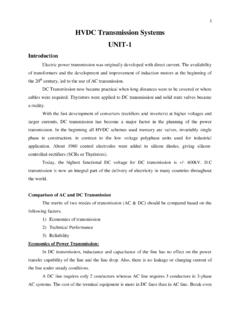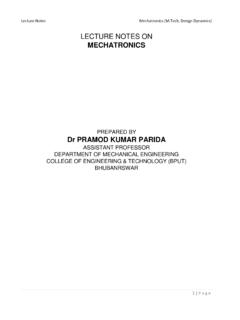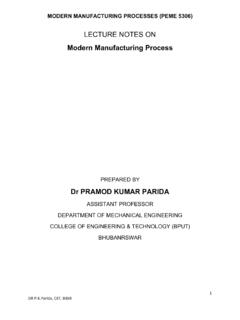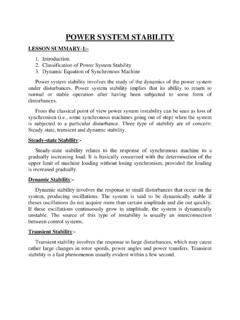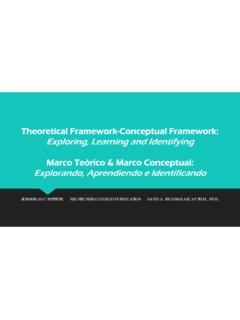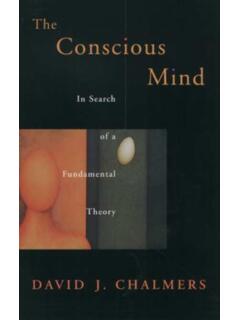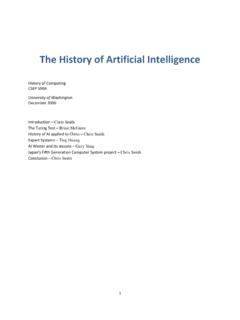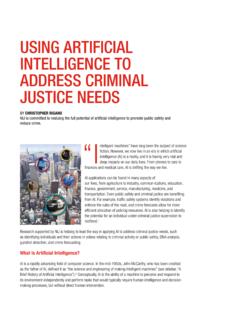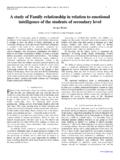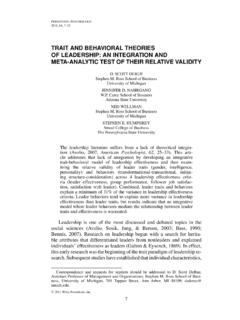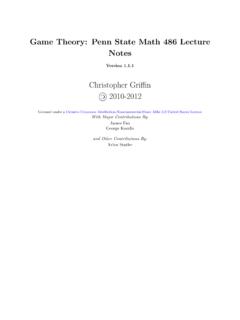Transcription of COLLEGE OF ENGINEERING AND TECHNOLOGY, …
1 LECTURE NOTES. ON. ARTIFICIAL intelligence . PREPARED BY. DR. PRASHANTA KUMAR PATRA. COLLEGE OF ENGINEERING AND TECHNOLOGY, BHUBANESWAR. 1. ARTIFICIAL intelligence SYLLABUS. Module 1 12 Hrs What is Artificial intelligence ? AI Technique, Level of the Model,Problem Spaces, and Search: Defining the Problem as a State Space Search, Production Systems, Problem Characteristics, Production System Characteristics, Issues in the Design of Search Programs. Heuristic Search Techniques: Generate-and- Test, Hill Climbing, Best-first Search, Problem Reduction, Constraint Satisfaction, Means-ends Analysis, Knowledge Representation: Representations and Mappings, Approaches to Knowledge Representation, Using Predicate Logic: Representing Simple Facts in Logic, Representing Instance and ISA Relationships, Computable Functions and Predicates, Resolution, Natural Rules: Procedural Versus Declarative Knowledge, Logic Programming, Forward Versus Backward Reasoning, Matching, Control Reasoning Under Uncertainty: Introduction to Nonmonotonic Reasoning, Logics for Nonmonotonic Reasoning, Implementation Issues, Augmenting a Problem-solver, Depth-first Search, Breadthfirst and Strong Slot-and-Filler Structures: Semantic Nets, Frames, Conceptual Dependency Scripts, CYC.
2 Module 2 10 Hrs Game Playing: The Minimax Search Procedure, Adding Alpha-beta Cutoffs, Iterative : The Blocks World, Components of a Planning System, Goal Stack Planning, Nonlinear Planning Using Constraint Posting, Hierarchical PlanningOther Planning : What is Understanding, What Makes Understanding Hard?, Understanding as Constraint Language Processing: Introduction, Syntactic Processing, Semantic Analysis, Discourse and Pragmatic Processing, Statistical Natural Language Processing, Spell Checking. Module 3 8 Hrs Learning: Rote Learning, learning by Taking Advice, Learning in Problem-solving, Learning from Examples: Induction, Explanation-based Learning, Discovery, Analogy, Formal Learning theory , Neural Net Learning and Genetic Learning. Expert Systems: Representing and Using Domain Knowledge, Expert System Shells, Explanation, Knowledge Acquisition. Text Book: 1. Elaine Rich, Kevin Knight, & Shivashankar B Nair, Artificial intelligence , McGraw Hill, 3rd ed.
3 ,2009. References: 1) Introduction to Artificial intelligence & Expert Systems, Dan W Patterson, PHI.,2010. 2) S Kaushik, Artificial intelligence , Cengage Learning, 1st 2. Module 1. ARTIFICIAL intelligence . What is Artificial intelligence ? It is a branch of Computer Science that pursues creating the computers or machines as intelligent as human beings. It is the science and ENGINEERING of making intelligent machines, especially intelligent computer programs. It is related to the similar task of using computers to understand human intelligence , but AI does not have to confine itself to methods that are biologically observable Definition: Artificial intelligence is the study of how to make computers do things, which, at the moment, people do better. According to the father of Artificial intelligence , John McCarthy, it is The science and ENGINEERING of making intelligent machines, especially intelligent computer programs . Artificial intelligence is a way of making a computer, a computer-controlled robot, or a software think intelligently, in the similar manner the intelligent humans think.
4 AI is accomplished by studying how human brain thinks and how humans learn, decide, and work while trying to solve a problem, and then using the outcomes of this study as a basis of developing intelligent software and systems. It has gained prominence recently due, in part, to big data, or the increase in speed, size and variety of data businesses are now collecting. AI can perform tasks such as identifying patterns in the data more efficiently than humans, enabling businesses to gain more insight out of their data. From a business perspective AI is a set of very powerful tools, and methodologies for using those tools to solve business problems. From a programming perspective, AI includes the study of symbolic programming, problem solving, and search. AI Vocabulary intelligence relates to tasks involving higher mental processes, creativity, solving problems, pattern recognition, classification, learning, induction, deduction, building analogies, optimization, language processing, knowledge and many more.
5 intelligence is the computational part of the ability to achieve goals. Intelligent behaviour is depicted by perceiving one's environment, acting in complex environments, learning and understanding from experience, reasoning to solve problems and discover hidden knowledge, applying knowledge successfully in new situations, thinking abstractly, using analogies, communicating with others and more. 3. Science based goals of AI pertain to developing concepts, mechanisms and understanding biological intelligent behaviour. The emphasis is on understanding intelligent behaviour. ENGINEERING based goals of AI relate to developing concepts, theory and practice of building intelligent machines. The emphasis is on system building. AI Techniques depict how we represent, manipulate and reason with knowledge in order to solve problems. Knowledge is a collection of facts'. To manipulate these facts by a program, a suitable representation is required. A good representation facilitates problem solving.
6 Learning means that programs learn from what facts or behaviour can represent. Learning denotes changes in the systems that are adaptive in other words, it enables the system to do the same task(s) more efficiently next time. Applications of AI refers to problem solving, search and control strategies, speech recognition, natural language understanding, computer vision, expert systems, etc. Problems of AI: intelligence does not imply perfect understanding; every intelligent being has limited perception, memory and computation. Many points on the spectrum of intelligence versus cost are viable, from insects to humans. AI seeks to understand the computations required from intelligent behaviour and to produce computer systems that exhibit intelligence . Aspects of intelligence studied by AI include perception, communicational using human languages, reasoning, planning, learning and memory. The following questions are to be considered before we can step forward: 1.
7 What are the underlying assumptions about intelligence ? 2. What kinds of techniques will be useful for solving AI problems? 3. At what level human intelligence can be modelled? 4. When will it be realized when an intelligent program has been built? Branches of AI: A list of branches of AI is given below. However some branches are surely missing, because no one has identified them yet. Some of these may be regarded as concepts or topics rather than full branches. Logical AI In general the facts of the specific situation in which it must act, and its goals are all represented by sentences of some mathematical logical language. The program decides what to do by inferring that certain actions are appropriate for achieving its goals. 4. Search Artificial intelligence programs often examine large numbers of possibilities for example, moves in a chess game and inferences by a theorem proving program. Discoveries are frequently made about how to do this more efficiently in various domains.
8 Pattern Recognition When a program makes observations of some kind, it is often planned to compare what it sees with a pattern. For example, a vision program may try to match a pattern of eyes and a nose in a scene in order to find a face. More complex patterns are like a natural language text, a chess position or in the history of some event. These more complex patterns require quite different methods than do the simple patterns that have been studied the most. Representation Usually languages of mathematical logic are used to represent the facts about the world. Inference Others can be inferred from some facts. Mathematical logical deduction is sufficient for some purposes, but new methods of non-monotonic inference have been added to the logic since the 1970s. The simplest kind of non-monotonic reasoning is default reasoning in which a conclusion is to be inferred by default. But the conclusion can be withdrawn if there is evidence to the divergent.
9 For example, when we hear of a bird, we infer that it can fly, but this conclusion can be reversed when we hear that it is a penguin. It is the possibility that a conclusion may have to be withdrawn that constitutes the non-monotonic character of the reasoning. Normal logical reasoning is monotonic, in that the set of conclusions can be drawn from a set of premises, monotonic increasing function of the premises. Circumscription is another form of non-monotonic reasoning. Common sense knowledge and Reasoning This is the area in which AI is farthest from the human level, in spite of the fact that it has been an active research area since the 1950s. While there has been considerable progress in developing systems of non-monotonic reasoning and theories of action, yet more new ideas are needed. Learning from experience There are some rules expressed in logic for learning. Programs can only learn what facts or behaviour their formalisms can represent, and unfortunately learning systems are almost all based on very limited abilities to represent information.
10 Planning Planning starts with general facts about the world (especially facts about the effects of actions), facts about the particular situation and a statement of a goal. From these, planning programs generate a strategy for achieving the goal. In the most common cases, the strategy is just a sequence of actions. Epistemology This is a study of the kinds of knowledge that are required for solving problems in the world. Ontology Ontology is the study of the kinds of things that exist. In AI the programs and sentences deal with various kinds of objects and we study what these kinds are and what their basic properties are. Ontology assumed importance from the 1990s. 5. Heuristics A heuristic is a way of trying to discover something or an idea embedded in a program. The term is used variously in AI. Heuristic functions are used in some approaches to search or to measure how far a node in a search tree seems to be from a goal. Heuristic predicates that compare two nodes in a search tree to see if one is better than the other, constitutes an advance toward the goal, and may be more useful.
